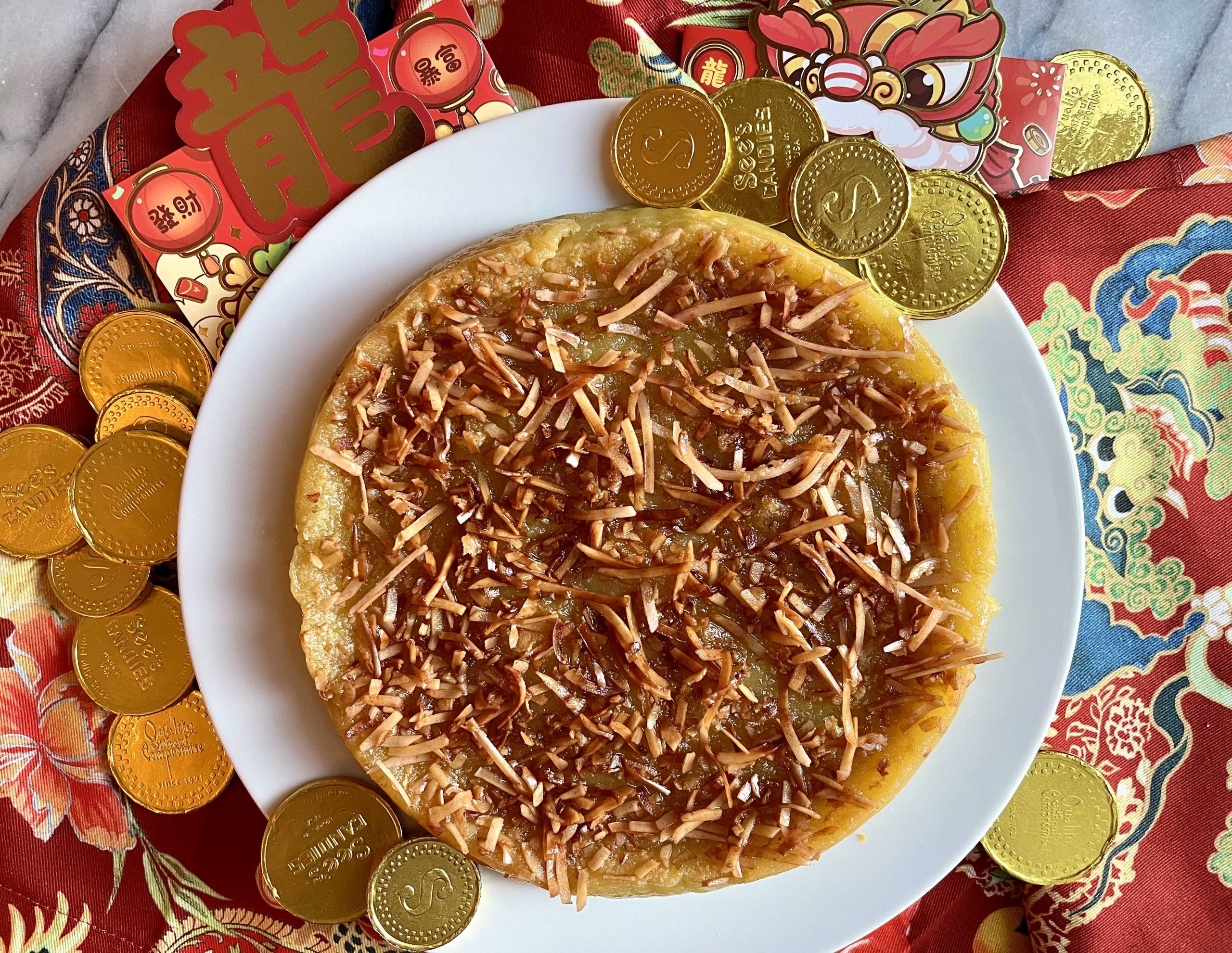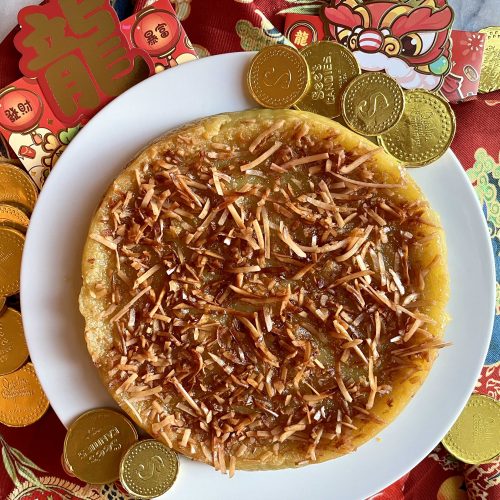February 10th, marks the Lunar New Year, the Year of the Dragon. Of the twelve animals of the Chinese zodiac, the dragon is the only mythical creature and symbolizes good fortune and strength. It is said that the lunar year harnesses the powers of its zodiac animal, so we are in for a favorable year!
Those born in the Year of the Dragon, 2024, 2012, 2000, 1988, 1976, 1964, 1952, and each preceding 12-year cycle; are said to have intelligent, confident and enthusiastic personalities. Our family is excited for the arrival of a new granddaughter and grandnephew in the coming months!
A tradition in most Chinese families at Lunar New Year is nian gao (translation “Year Cake”). Most common is a steamed cake made of sweet rice flour and minimally processed cane sugar. We decorate it with sesame seeds and dried jujubes, aka Chinese dates; and steam it in a bed of bamboo leaves.
This recipe, adapted from What to Cook Today, is a slight twist, using coconut milk, granulated sugar, and baking the cake in a standard, 350°F oven. It’s an easier approach, especially if you do not regularly steam foods and have a large steaming set-up.
“Mochi cakes” have become very mainstream these days, mochi being the sweet rice flour base in place of wheat flour. They are adored for their soft and bouncy texture and are gluten-free.
Mochiko brand sweet rice flour, from Koda Farms, is a popular brand available in many grocery markets. If you are shopping in an Asian market, look for the package with green labeling. (The package with red labeling are for regular rice flour, not glutinous sweet rice flour and it is NOT a substitute in this recipe.)


Coconut Mochi Cake - aka Chinese Nian Gao for Lunar New Year
Ingredients
- 1/4 cup flaked coconut unsweetened
- 1-1/4 cup glutinous, sweet rice flour
- 1 cup granulated sugar
- 1/8 teaspoon sea salt
- 2 extra-large eggs
- 1-1/2 cups whole-fat coconut milk
- 2 tablespoons unsalted butter melted then cooled slightly; plus additional butter for the pan
- 1/2 teaspoon coconut extract
Instructions
- Toast the coconut flakes in a small, shallow pan over medium heat, stirring frequently, about five minutes until the edges of the flakes just begin to turn golden. Remove from the heat, transferring to a dish if needed to stop the browning. Set aside.
- Generously butter the sides of the cake pan and line the bottom with parchment paper. Position an oven rack one-third from the bottom of the oven. Preheat the oven to 350°F.
- Melt the 2 tablespoons of butter then transfer to a medium bowl. Add the 2 eggs and coconut extract then mix until combined. Add the coconut milk and mix again until well combined. (If the coconut milk has separated, warm the coconut milk in a small saucepan over very low heat to re-emulsify. The coconut fat will melt at about 75°F – 80°F.) This recipe uses all except a few tablespoons of a typical 13.5 fl oz/400 mL can.
- Mix the sweet rice flour, sugar, and salt together in a large bowl. Make a well in the center of the dry ingredients and add the liquid ingredients, stirring with a whisk to achieve a smooth, thin batter. Try to remove any lumps of dry ingredients, straining if needed before pouring into the prepared pan.
- Bake for 30 minutes then carefully remove from the oven (thcake will have risen slightly and begin to firm around the edges); and sprinklon the reserved toasted coconut atop.
- Return to the oven and bake an additional 20 – 25 minutes until the cake is golden brown and the center is just barely set. A toothpick inserted into the center of the cake should come out with a few sticky bits, but not wet. Total baking time is about 50 – 55 minutes.
- Remove the cake from the oven and let cool for several hours before attempting to remove from the pan and cut. The cake is very soft and needs time to cool and set firmly. Overnight in the refrigerator is also fine.
- A traditional serving is with fresh Mandarin oranges. Chocolate coins are also popular at our house!

